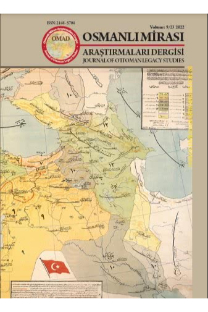ACCULTURATION THROUGH MIGRATION IN THE ROMANIAN COUNTRIES: OTTOMAN PRODUCTS AND SOCIAL CHANGE
Romen Ülkelerinde Göçle Gelen Kültürel Etkileşim: Osmanlı Ürünleri ve Sosyal Değişim
___
Călători străini despre Țările Române, vol. IX, ed. by Maria Holban, edt. Academiei Române, București 1997.Cerasi, Maurice, “The Formation of Ottoman house types: A comparative study in interaction with neighboring countries”, in Muqarnas, no. 15 /1998, pp. 116-56.
Chatziioannou, Maria-Christina, “Greek Merchant Networks in the Age of Empires (1770- 1870)”, in Ina Baghdiantz McCabe, Gelina Harlaftis & Ioanna Pepelasis Minoglou (eds),
Diaspora Entrepreneurial Networks: Four Centuries of History, Oxford and New York: Berg, 2005, pp. 371-82.
Dinu, Tudor, Bucureștiul fanariot. Administrație, meșteșuguri, negoț, vol. 2, București, edt. Humanitas, 2017.
IOM Glossary on Migration, 2nd edition, published by International Organization on Migration, 2011, https://publications.iom.int/system/files/pdf/iml25_1.pdf, accessed on August 5 2019.
Ionescu, Adrian-Silvan, Modă și societate urbană, București, Edit. Paideia 2006.
Ionescu, Ștefan, Bucureștii în vremea fanarioților, Editura Dacia, Cluj 1974.
Iorga, Nicolae, Documente grecești privitoare la Istoria Românilor, c. 1560-c.1820., colecția Hurmuzaki, vol. XIV, București 1936.
Iorga, Nicolae, Scrisori de boieri și negustori olteni și munteni către casa de negoț sibiiană Hagi Pop, publicate cu note genealogice asupra mai multor familii, București, Atelierele grafice SOCEC& Comp, Societate anonimă, 1906.
İnalcık, Halil, Quataert, Donald (edt.), An Economic and Social History of the Ottoman Empire, vol. 2, Cambridge University Press, 1997, pp. 698-704.
Pratt, Mary Louise, `Arts of the Contact Zone` in Profession, 1991, Modern Language Association, pp. 30-40, https://www.jstor.org/stable/25595469, accessed on August 2019.
Urechia, V.A., Istoria Românilor, curs făcut la Facultatea de Litere din Bucuresti dupe documente inedite, seria 1786-1800, volume II, Tipografia și Fonderia de Litere Thoma Basilescu, Bucuresci 1894.
Vintilă-Ghițulescu, Constanța, Patimă și desfătare. Despre lucrurile mărunte ale vieții cotidiene în societatea românească (1750-1860),București, edt. Humanitas, 2017.
- ISSN: 2148-5704
- Yayın Aralığı: 3
- Başlangıç: 2014
- Yayıncı: Abidin Temizer
II. ABDÜLHAMİD İMARI KARESİ İDADİ VE SULTANİSİNİN MİMARİ ANALİZİ VE RESTORASYON ÖNERİLERİ
KARADENİZ’DE BİR OSMANLI MADEN YERLEŞKESİ: KAB-I MADEN KAZASI (1264-1856)
ACCULTURATION THROUGH MIGRATION IN THE ROMANIAN COUNTRIES: OTTOMAN PRODUCTS AND SOCIAL CHANGE
AKSARAYLI HASAN RIZÂÎ’NİN SAD-KELİME-İ ALÎ TERCÜMESİ
Romen Ülkelerinde Göçle Gelen Kültürel Etkileşim: Osmanlı Ürünleri ve Sosyal Değişim
Kavramsal Entegrasyon Büyüteci Altında Yusuf Franko’nun Karikatürleri
NIHADA DELIBEGOVIĆ DŽANIĆ, MIRZA DŽANIĆ
